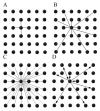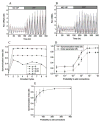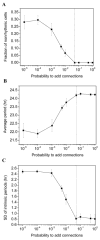Small-world network models of intercellular coupling predict enhanced synchronization in the suprachiasmatic nucleus
- PMID: 19465701
- PMCID: PMC2819153
- DOI: 10.1177/0748730409333220
Small-world network models of intercellular coupling predict enhanced synchronization in the suprachiasmatic nucleus
Abstract
The suprachiasmatic nucleus (SCN) of the hypothalamus is a multioscillator system that drives daily rhythms in mammalian behavior and physiology. Based on recent data implicating vasoactive intestinal polypeptide (VIP) as the key intercellular synchronizing agent, we developed a multicellular SCN model to investigate the effects of cellular heterogeneity and intercellular connectivity on circadian behavior. A 2-dimensional grid was populated with 400 model cells that were heterogeneous with respect to their uncoupled rhythmic behavior (intrinsic and damped pacemakers with a range of oscillation periods) and VIP release characteristics (VIP producers and nonproducers). We constructed small-world network architectures in which local connections between VIP producing cells and their 4 nearest neighbors were augmented with random connections, resulting in long-range coupling across the grid. With only 10% of the total possible connections, the small-world network model was able to produce similar phase synchronization indices as a mean-field model with VIP producing cells connected to all other cells. Partial removal of random connections decreased the synchrony among neurons, the amplitude of VIP and cAMP response element binding protein oscillations, the mean period of intrinsic periods across the population, and the percentage of oscillating cells. These results indicate that small-world connectivity provides the optimal compromise between the number of connections and control of circadian amplitude and synchrony. This model predicts that small decreases in long-range VIP connections in the SCN could have dramatic effects on period and amplitude of daily rhythms, features commonly described with aging.
Figures





Similar articles
-
Effect of network architecture on synchronization and entrainment properties of the circadian oscillations in the suprachiasmatic nucleus.PLoS Comput Biol. 2012;8(3):e1002419. doi: 10.1371/journal.pcbi.1002419. Epub 2012 Mar 8. PLoS Comput Biol. 2012. PMID: 22423219 Free PMC article.
-
A neuropeptide speeds circadian entrainment by reducing intercellular synchrony.Proc Natl Acad Sci U S A. 2013 Nov 12;110(46):E4355-61. doi: 10.1073/pnas.1307088110. Epub 2013 Oct 28. Proc Natl Acad Sci U S A. 2013. PMID: 24167276 Free PMC article.
-
Multicellular model for intercellular synchronization in circadian neural networks.Biophys J. 2011 Jul 6;101(1):12-20. doi: 10.1016/j.bpj.2011.04.051. Biophys J. 2011. PMID: 21723810 Free PMC article.
-
The roles of vasoactive intestinal polypeptide in the mammalian circadian clock.J Endocrinol. 2003 Apr;177(1):7-15. doi: 10.1677/joe.0.1770007. J Endocrinol. 2003. PMID: 12697032 Review.
-
Cell autonomy and synchrony of suprachiasmatic nucleus circadian oscillators.Trends Neurosci. 2011 Jul;34(7):349-58. doi: 10.1016/j.tins.2011.05.003. Epub 2011 Jun 12. Trends Neurosci. 2011. PMID: 21665298 Free PMC article. Review.
Cited by
-
Phase Gradients and Anisotropy of the Suprachiasmatic Network: Discovery of Phaseoids.eNeuro. 2021 Sep 9;8(5):ENEURO.0078-21.2021. doi: 10.1523/ENEURO.0078-21.2021. Print 2021 Sep-Oct. eNeuro. 2021. PMID: 34385151 Free PMC article.
-
Suprachiasmatic nucleus-wide estimation of oscillatory temporal dynamics.PLoS Comput Biol. 2025 Mar 6;21(3):e1012855. doi: 10.1371/journal.pcbi.1012855. eCollection 2025 Mar. PLoS Comput Biol. 2025. PMID: 40048409 Free PMC article.
-
The Suprachiasmatic Nucleus at 50: Looking Back, Then Looking Forward.J Biol Rhythms. 2024 Apr;39(2):135-165. doi: 10.1177/07487304231225706. Epub 2024 Feb 16. J Biol Rhythms. 2024. PMID: 38366616 Free PMC article. Review.
-
Timing of neuropeptide coupling determines synchrony and entrainment in the mammalian circadian clock.PLoS Comput Biol. 2014 Apr 17;10(4):e1003565. doi: 10.1371/journal.pcbi.1003565. eCollection 2014 Apr. PLoS Comput Biol. 2014. PMID: 24743470 Free PMC article.
-
Mechanists Must be Holists Too! Perspectives from Circadian Biology.J Hist Biol. 2016 Dec;49(4):705-731. doi: 10.1007/s10739-016-9439-6. J Hist Biol. 2016. PMID: 26966017
References
-
- Abrahamson EE, Moore RY. Suprachiasmatic nucleus in the mouse: Retinal innervation, intrinsic organization and efferent projections. Brain Res. 2001;916:172–191. - PubMed
-
- Albert R, Barabasi AL. Statistical mechanics of complex networks. Rev Mod Phys. 2002;74:47–97.
-
- Antle MC, Silver R. Orchestrating time: Arrangements of the brain circadian clock. Trends Neurosci. 2005;28:145–151. - PubMed
-
- Asai M, Yoshinobu Y, Kaneko S, Mori A, Nikaido T, Moriya T, Akiyama M, Shibata S. Circadian profile of Per gene mRNA expression in the suprachiasmatic nucleus, paraventricular nucleus, and pineal body of aged rats. J Neurosci Res. 2001;66:1133–1139. - PubMed
Publication types
MeSH terms
Substances
Grants and funding
LinkOut - more resources
Full Text Sources

